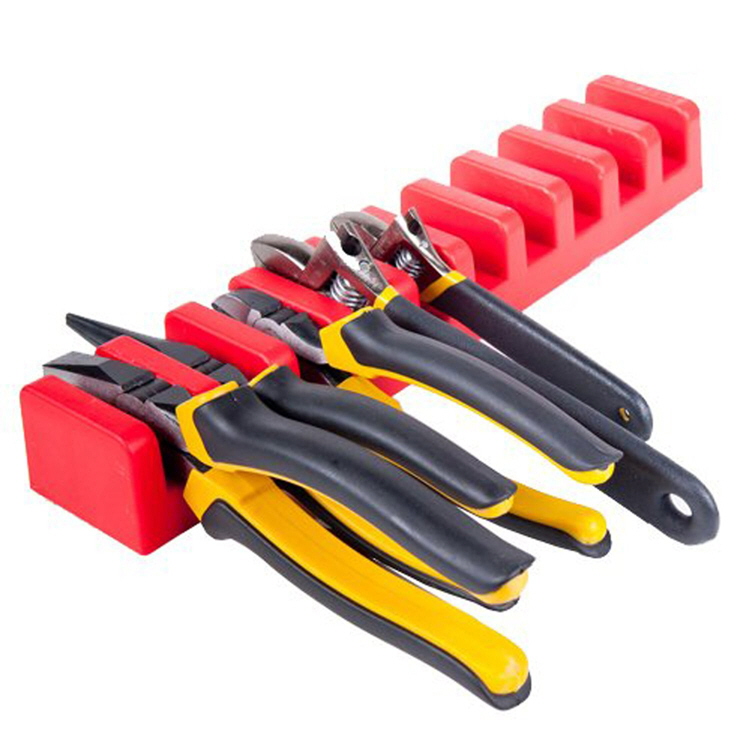
Different Ways to Store Pliers, from Store-Bought to DIY
It's quite the design problem: Vertical, horizontal, exposed, in a drawer, jaws-out, handles-out?
Pliers are tricky things to store. They don't lend themselves to pegboad, as wedging them into a hook by their crotches is defeated by simple gravity. If you obey gravity and store them flat in a drawer, their awkward splay-handled shape takes up an undue amount of space, and they don't neatly "nest" the way wrenches do.
Thus folks have devised manifold ways to store them. The only consensus seems to be that, no matter how they are oriented, pliers ought be stored face-to-face (in the manner of books) as opposed to side-by-side (in the manner of pictures on a wall).
Vertical, Jaws-Up
This rack by Plyworx aims for flexibility. It can be rested on a shelf/worksurface or hung from a wall, if you want to keep the tools exposed and stored vertically.
 Enter a caption (optional)
Enter a caption (optional) Enter a caption (optional)
Enter a caption (optional) Enter a caption (optional)
Enter a caption (optional)Alternatively it can be placed in a drawer, jaws-out. That makes it easy to see which pair is which, but isn't convenient for grabbing them.
 Enter a caption (optional)
Enter a caption (optional)Horizontal, Handles-Out
In contrast, this simple Pliers Organizer is meant to be stored in a drawer, handles-out.
 Enter a caption (optional)
Enter a caption (optional)The paradox of handles-out/easier-to-grab means that you must pull the drawer all the way out to see which jaw style you're grabbing. But you can get 'round this by storing the thing sideways, as long as your drawer is 12 inches wide.
 Enter a caption (optional)
Enter a caption (optional)Magnetic, Any-Which-Way
At first glance, this Torin Magnetic Plier Holder doesn't look like much:
 Enter a caption (optional)
Enter a caption (optional)But it has magnets both to hold the individual tools in place, and along the back to allow it to stick to a metal cabinet. Which means it can be oriented any way you want:
Horizontal, Wire, Jaws-Out
Another solution is to go with wire, as with this rather inelegant rack:
 Enter a caption (optional)
Enter a caption (optional)That design seems like it requires fiddling to get the tools in and out, but I suppose it's functional. And the benefit of wire is that you can trim it to fit your drawers.
Horizontal, Wire, DIY
This toolie on YouTube shows you how to make a DIY plier rack out of your average wire closet shelf. To do it, he makes his own brake out of a couple of 2x4s:
Wedge Method, Jaws-Up, DIY
For a really quick-'n-dirty option, you can take a 2x4, do two angled cuts on a table saw, and book-end it with scraps to get this system:
Jaws-Up, Uniform Handles
If you're like me, you buy your pliers piecemeal and the handle widths, sizes and colors all vary widely. But companies like Wubbers Pliers that manufacture complete sets, like these 28 different jeweler's pliers, can pick a single handle profile and apply it to everything they offer. They can get away with that because the leverage required to produce jewelry may not vary as widely as it does in a shop with more broad needs. And the advantage of that uniformity is that one can create elegantly simple holders for them:
As much as the simple Wubbers holders scratch that OCD itch, and allow you to clearly see the jaws, they don't seem all that ergonomic; imagine grabbing one from the middle.
So, it seems there's no silver-bullet solution, particularly since everyone has different needs.
I confess I haven't purchased or DIY'd any of these solutions—my own pliers are still messily shoved in a drawer and mixed in with wrenches. How do you guys and gals store yours?
-
oFavorite This
-
Q4Comment
K
{Welcome
Create a Core77 Account
Already have an account? Sign In
By creating a Core77 account you confirm that you accept the Terms of Use
K
Reset Password
Please enter your email and we will send an email to reset your password.


Comments
All of these plier storage units store them perpendicular to the back. If they would just tilt the plane of the pliers so that they're at 45˚, it would be easier to see what kind of pliers are being stored, since most people identify pliers based on viewing them from the broad side, in order to see the shape of the jaws.
Since pliers are usually semetrical, with handles significantly heavier than their jaws, they sit beautifully stable on a rail, balancing just below the fulcrum. Round metal that's relatively thin but strong enough to take the weight should work well. The only downside I can think of is that springs occasionally get caught on the rail. The photo shows some of mine on a long pegboard peg, a thin towel rail also works well.
I suppose this ignores the obvious shadowing them in foam inside shallow drawers, which accomplishes organizing them, as well as highlighting when they are missing. I vote shadowing every time. As David points out below, its not worth losing a deep drawer over.
The other challenge is deciding wether its worth allocating one of the deep drawers in your toolbox for a system. In many/most toolboxes, the number of deeper drawers is limited and reserved for the big items-air tools/power tools, torque wrenches, hammers. Plier usually can fit laying flat in one of the thin drawers. I don't know if I'd sacrifice a deep drawer to accommodate a rack of any kind. Mine just lay flat, manually nested small inside big as much as possible.